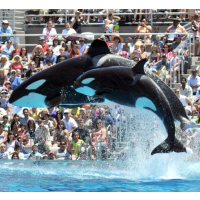SeaWorld Orca Show Goes on as Ban Dies in Legislature
 (photo: SeaWorld San Diego)
(photo: SeaWorld San Diego)
State legislation, ballyhooed by animal rights advocates last month, that would put an end to orca shows at San Diego's SeaWorld died Tuesday without even a committee vote.
The bill's author, Assemblyman Richard Bloom (D-Westside L.A.), said the legislation is not dead but it is, and he acknowledged that it won't be reintroduced until next year at the earliest. The decision by the Assembly Water, Parks and Wildlife Committee not to vote on the matter deep-sixed it and saved the Assembly's soon-to-be Speaker, Toni Atkins, the uncomfortable chore of having to deal with it. SeaWorld is in her district.
Bloom said he was OK with the committee's action and it would give everyone a chance to study the issue for a future vote. The first-term Assemblyman called it “a positive step forward.” But SeaWorld San Diego President John Reilly told U-T San Diego he thought the legislation was “fatally flawed” and there was no room for compromise on it.
Bloom introduced Assembly Bill 2140 after seeing the documentary “Blackfish,” a documentary built around the Orlando SeaWorld orca Tilikum that killed three people (two trainers and a trespasser) and the conditions of captivity that may have contributed to its behavior.
The bill would have made “it unlawful to hold in captivity, or use, a wild-caught or captive-bred orca, as defined, for performance or entertainment purposes.” The orcas would be moved into a larger sea pen and could not be bred.
The main issue debated, before the committee canned the bill, was whether the killer whales are thriving as performing show animals in a constrained habitat or being brutalized by it. “They are just too large, too intelligent, too socially complex, and they are too far-ranging to be put in confinement this way,” Naomi Rose, a marine mammal scientist with the Animal Welfare Institute, told the San Francisco Chronicle.
But the future of SeaWorld's orca research center is part of the debate, as is money. Especially money. The 10 orcas at SeaWorld are big business. They are the main attraction that reportedly draws around 4.4 million visitors a year from all around the world, comparable to the world famous San Diego Zoo. The park generates 4,000 jobs and pays the city $9.6 million in rent.
There are approximately 53 orcas known to be in captivity. SeaWorld critics say all evidence points toward animal abuse. The captive killer whales' lives are short and they are prone to disease, have difficulty breeding, display extreme aggression and in some cases appear to be a bit nuts, they say.
Nonsense, says Dr. Chris Dold, vice president of veterinary services for SeaWorld San Diego. “To be clear, the whales at SeaWorld are thriving,” he said, and any changes in their environment now would disrupt their routines and “increase their health risks.”
The prisoners are much safer in their cages.
‒Ken Broder
To Learn More:
SeaWorld Bill Fails to Pass (by Michael Gardner, U-T San Diego)
California Orca Show Ban Bill Killed for This Year (by Jeremy B. White, Sacramento Bee)
Seaworld Killer Whale Ban Elicits Heated Debate (by Melody Gutierrez, San Francisco Chronicle)
Proposed California Law Would Free SeaWorld’s Orcas (by Brandon Keim, Wired)
Assemblyman Who Proposed Banning Orcas at SeaWorld May be Swimming with Sharks (by Ken Broder, AllGov California)
Safety Director Claims SeaWorld Ordered Her to Obstruct Whale Death Investigation (by Noel Brinkerhoff, AllGov)
- Top Stories
- Controversies
- Where is the Money Going?
- California and the Nation
- Appointments and Resignations
- Unusual News
- Latest News
- California Forbids U.S. Immigration Agents from Pretending to be Police
- California Lawmakers Urged to Strip “Self-Dealing” Tax Board of Its Duties
- Big Oil’s Grip on California
- Santa Cruz Police See Homeland Security Betrayal in Use of Gang Roundup as Cover for Immigration Raid
- Oil Companies Face Deadline to Stop Polluting California Groundwater





